
Lindley
Lovely little town, very picturesque when coming in from the north on the R707, I have not come from any other direction yet. Nestled between the hills on the bank of the Vals River with the big church forming a focal point, it just invites for a visit.
The Internet has a few websites dealing with Lindley, this one being the most general I found.
Its geographical position 27.8791°S, 27.9195°E and 1502m altitude.
History
The town was laid out in 1875 and proclaimed by the Volksraad in 1878.  It was named after Daniel (David) Lindley who was the first minister to the Voortrekkers in Natal, Freestate and the Transvaal.
It was named after Daniel (David) Lindley who was the first minister to the Voortrekkers in Natal, Freestate and the Transvaal.
The town saw plenty of action during the Boer War (1899-1902). The most significant being the capturing of the Imperial Yeomanry, a volunteer force sent to South Africa to help in the fight. Details further down.
Another significant event was the destruction of the town in February of 1902 by British forces, a measure to counter guerrilla attacks.
An extract from the SA Military history of what other people thought of the town.
According to Thomas Pakenham, the De Wets' (this would have been Piet de Wet) hometown was not a very inspiring place:'Lindley struck people as a depressing place. It was one of those strange, bare little towns, whose presence on the veld was so inexplicable: no visible roads led to it; no fertile fields, let alone trees or gardens, surrounded it; it was just a cluster of tin roofs and a bleak, tall church.'
Winston Churchill's eyewitness report was more favourable: 'Lindley is a typical South African town, with a large central market-square and four or five broad unpaved streets radiating therefrom. There is a small clean-looking hotel, a substantial gaol, a church and a school-house. But the two largest buildings are the general stores.'
Railway station
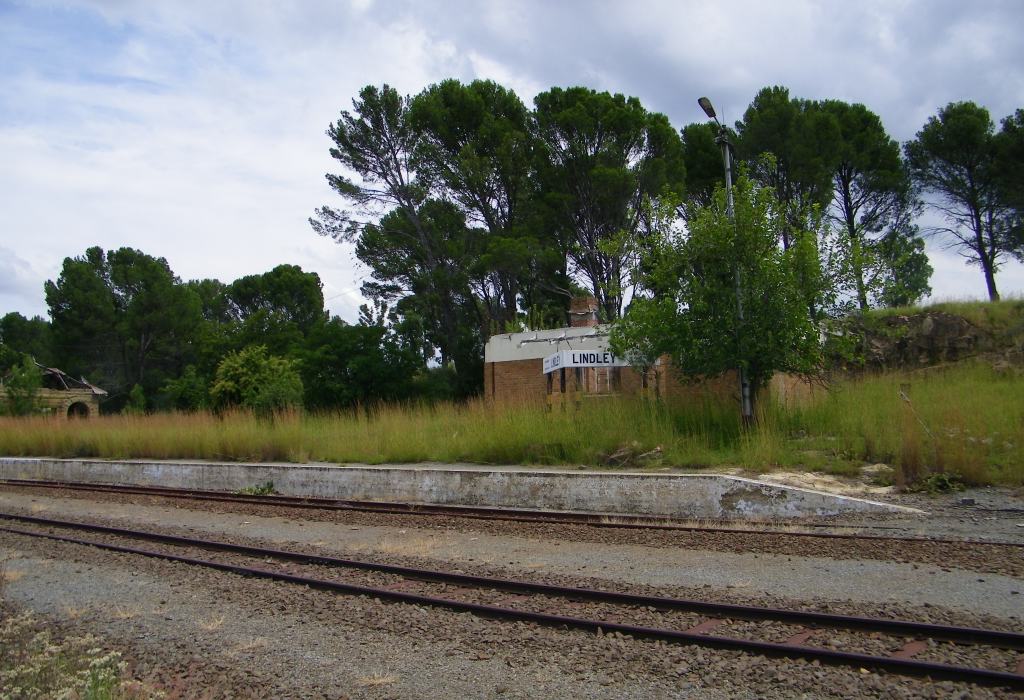 The line is dead, although there is talk of re-using it again as part of the infrastructure improvement. All the station buildings are derelict. This is part of the rail link from Wolwehoek in the north to Arlington in the south. It started with the rail from Wolwehoek to Heilbron in 1899, followed by the extension to Petrus Steyn in 1925 and the final link up to Arligton via Lindley in 1930. The line was actually pushed from both directions, the Arlington to Lindley piece was completed in 1929. At the same time work carried on to build the rail from Petrus Steyn to Lindley, that was completed in 1930.
The line is dead, although there is talk of re-using it again as part of the infrastructure improvement. All the station buildings are derelict. This is part of the rail link from Wolwehoek in the north to Arlington in the south. It started with the rail from Wolwehoek to Heilbron in 1899, followed by the extension to Petrus Steyn in 1925 and the final link up to Arligton via Lindley in 1930. The line was actually pushed from both directions, the Arlington to Lindley piece was completed in 1929. At the same time work carried on to build the rail from Petrus Steyn to Lindley, that was completed in 1930.
Townhall
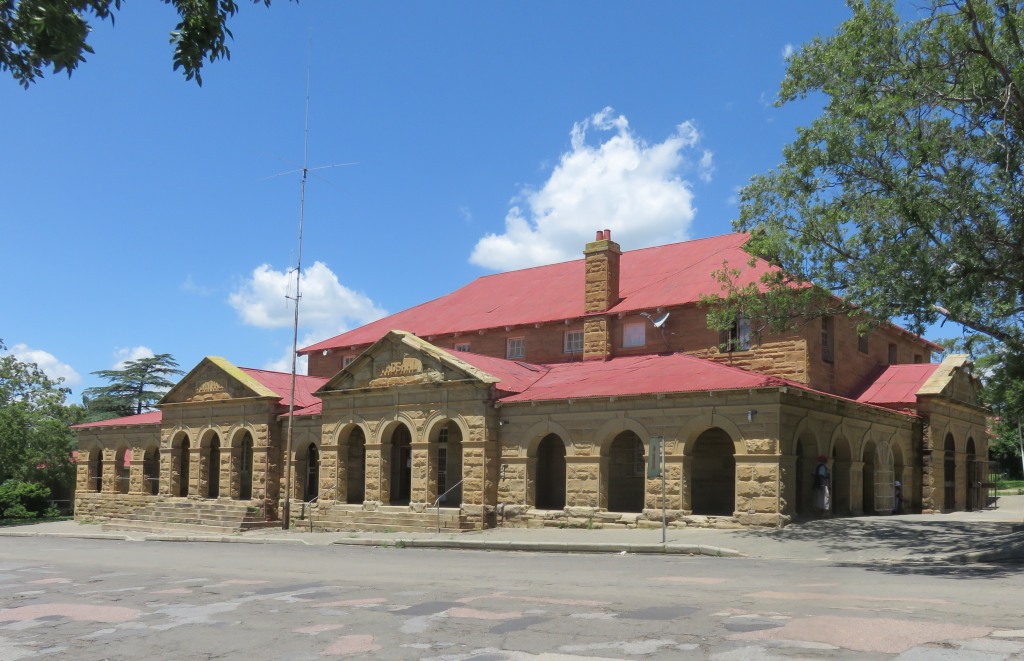
 The town hall was build in two stages. The picture from an newspaper published around 1928 shows only half the town hall. The inscription on the gable says it was build 1911 and the second part came in 1937.
The town hall was build in two stages. The picture from an newspaper published around 1928 shows only half the town hall. The inscription on the gable says it was build 1911 and the second part came in 1937.
Churches
NG Church

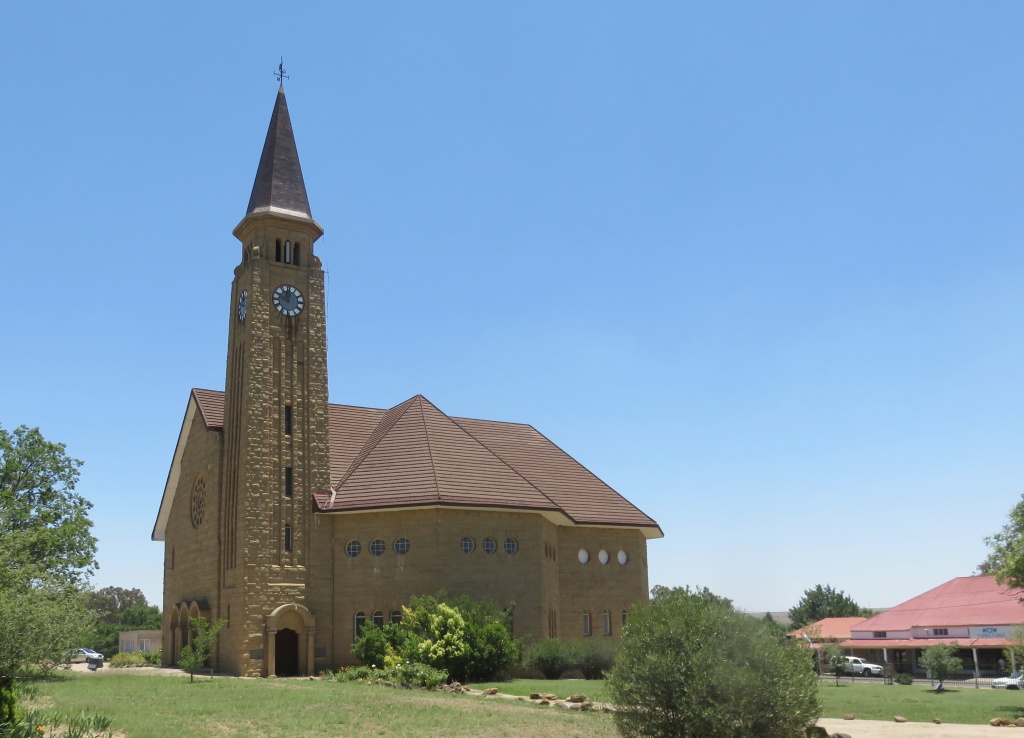 The area was served by the congregation of Harrismith. When the town started developing it was felt that there were enough members of the church to form their own congregation by seceding from Harrismith. The first NG church was built in 1876, it burned down in 1902 due to war action. A small replica of this church can be seen in the south east corner of the church yard. This replica also serves as a memorial for the fallen Boer soldiers of the Boer war (1899-1902).
The area was served by the congregation of Harrismith. When the town started developing it was felt that there were enough members of the church to form their own congregation by seceding from Harrismith. The first NG church was built in 1876, it burned down in 1902 due to war action. A small replica of this church can be seen in the south east corner of the church yard. This replica also serves as a memorial for the fallen Boer soldiers of the Boer war (1899-1902).
In the initial years pastoral services were provided by CP Theron from Bethlehem. By 1880 the congregation felt strong enough to have their own pastor. This turned out not to be straight forward, 11 invitations went out before they were successful. AJB Albertyn accepted the calling in 1884 and was thus the first full time minister of the congregation.
This turned out not to be straight forward, 11 invitations went out before they were successful. AJB Albertyn accepted the calling in 1884 and was thus the first full time minister of the congregation.
The burned out church was restored and put back into use by 1904. With time it became more pressing to have a new, larger church. The new church was built and inaugurated in 1928. The architect was Wynand Louw.
Methodist church
 The foundation stone was laid on the 19 Sept.1914. I am not sure the congregation still exists, the church has been sold (I presume) to the APK, that is the Afrikaanse Protestante Kerk.
The foundation stone was laid on the 19 Sept.1914. I am not sure the congregation still exists, the church has been sold (I presume) to the APK, that is the Afrikaanse Protestante Kerk.
Battle of the Yeomanry Hills
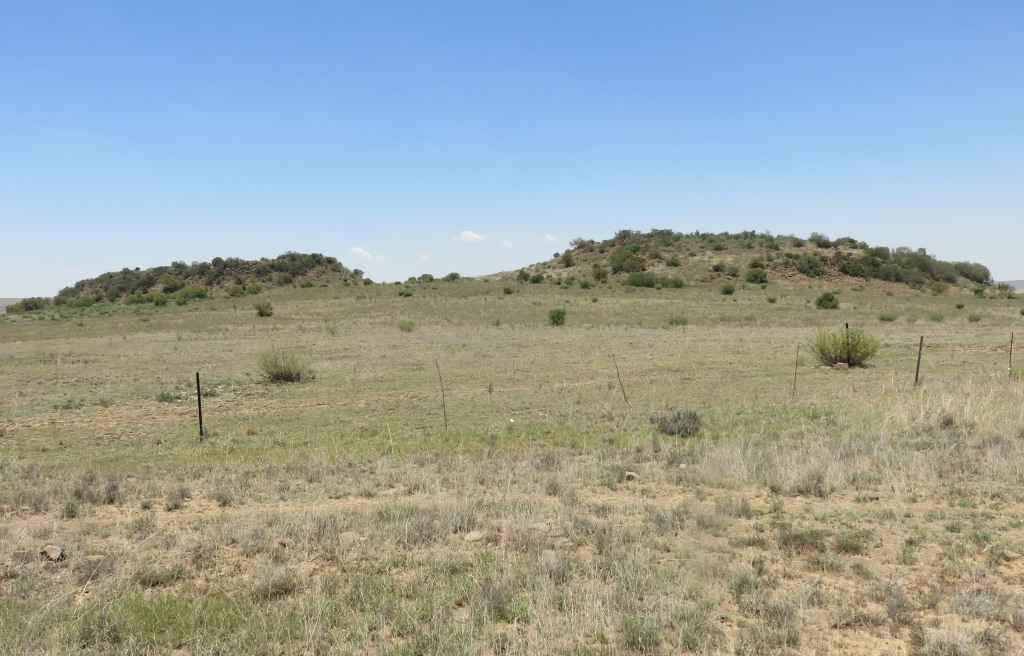
 There was action involving the 13th battalion of the Imperial Yeomanry under the command of Lt. Col. Spragge . The Yeomanry was a force made up mainly from volunteers. The background to the action at Lindley. The 13 battalion was moving up from Ventersburg to Kroonstad. In Kroonstad they received instructions to move to Lindley to join General Colville at Lindley. When they arived at Lindley on the 27 May 1900 they found that Gen Colville had left Lindley moving towards Heilbron and were surprised by the Boers defending the town. Fearing a trap they withdrew to the two koppies to the west of the town. This offered a defensible position.
There was action involving the 13th battalion of the Imperial Yeomanry under the command of Lt. Col. Spragge . The Yeomanry was a force made up mainly from volunteers. The background to the action at Lindley. The 13 battalion was moving up from Ventersburg to Kroonstad. In Kroonstad they received instructions to move to Lindley to join General Colville at Lindley. When they arived at Lindley on the 27 May 1900 they found that Gen Colville had left Lindley moving towards Heilbron and were surprised by the Boers defending the town. Fearing a trap they withdrew to the two koppies to the west of the town. This offered a defensible position.
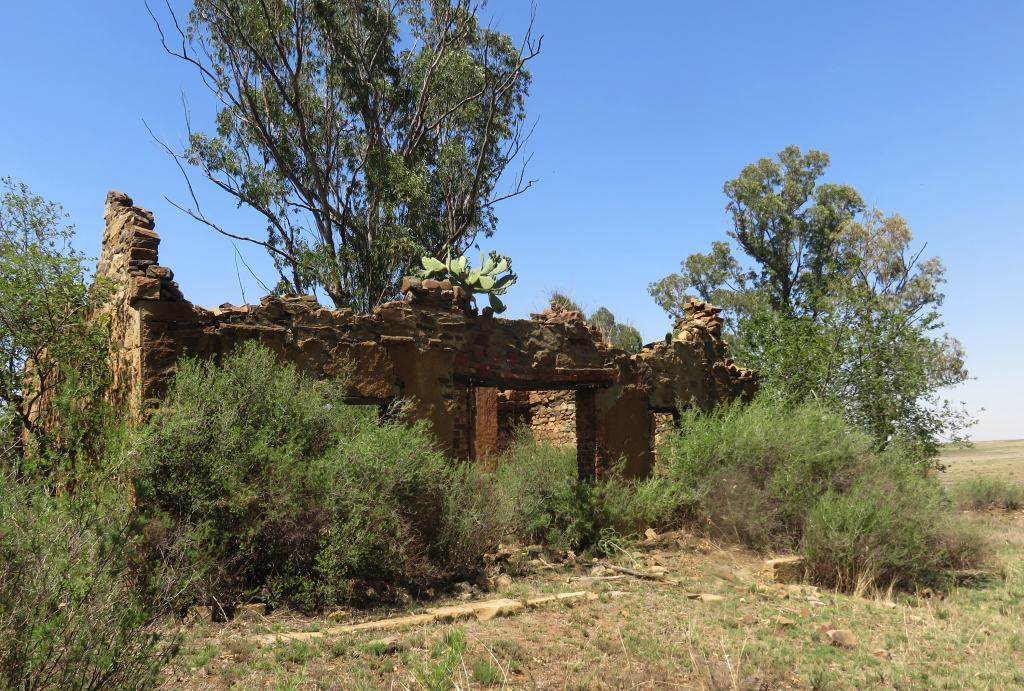 The Yeomanry occupied the two hills and some area around it that provided for water and some feed for the horses. On the west side was a farm house that was used by the officers and served as a temporary field hospital. The picture shows the ruin of that house. It was a bit of a complicated situation, one room was occupied by the farmer's wife and two children, whilst the boer was held prisoner in the shed. Near the shed was also the place where the fallen soldiers were buried until they were exhumed in 1959 to be transferred to the Lindley cemetery.
The Yeomanry occupied the two hills and some area around it that provided for water and some feed for the horses. On the west side was a farm house that was used by the officers and served as a temporary field hospital. The picture shows the ruin of that house. It was a bit of a complicated situation, one room was occupied by the farmer's wife and two children, whilst the boer was held prisoner in the shed. Near the shed was also the place where the fallen soldiers were buried until they were exhumed in 1959 to be transferred to the Lindley cemetery.
After four days of fighting the battalion had to surrender, this was under somewhat controversial circumstances as explained in Ref 5. The end result for the British was 23 dead and about 400 taken prisoners. Those were taken to Pretoria where they were released when the British took the town.
In the investigation that was done after the event it turned out that the signal ordering the battalion to move to Lindley had not come from Gen Corville, but was rather send off by the Boers using the still functioning telegraph system.
The site is marked by a monument on the east side of the east hill, see the picture above.
Cemetery
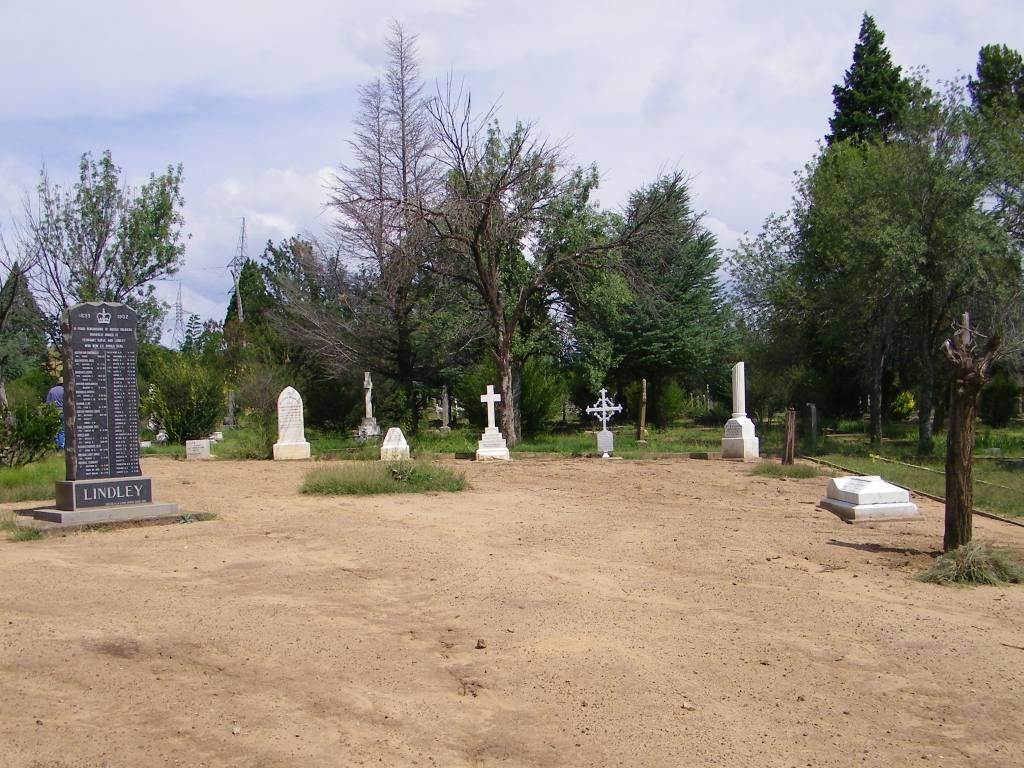
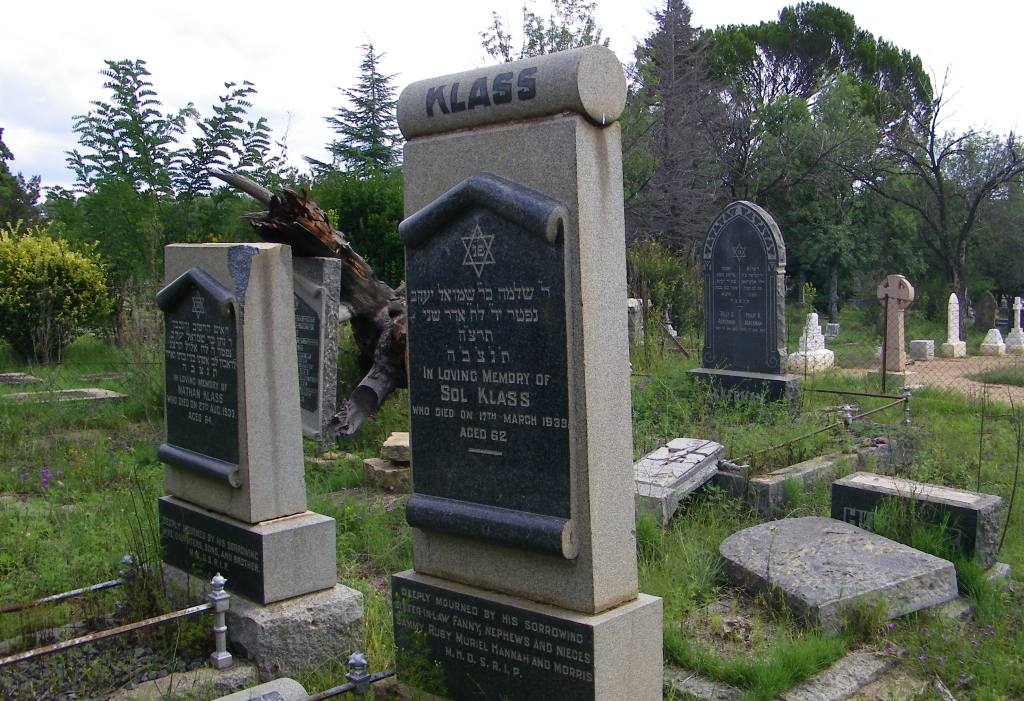 The British war graves as shown above are in this cemetery. Also of note are some Jewish graves, like every other town in the Free State, here was a strong Jewish community. On this picture one can see the grave stones still standing with one exeption. On a recent visit (Sept 2018) I noticed that all the stones have now been laid flat and are cemented in to foil vandalism. I have seen this done in other grave yards as well.
The British war graves as shown above are in this cemetery. Also of note are some Jewish graves, like every other town in the Free State, here was a strong Jewish community. On this picture one can see the grave stones still standing with one exeption. On a recent visit (Sept 2018) I noticed that all the stones have now been laid flat and are cemented in to foil vandalism. I have seen this done in other grave yards as well.
A few graves of special interest were pointed out to me.
Capt Sir John Power

 Known as the whiskey baron, he joined the Yeomanry as a volunteer to do service in South Africa. Born 1870 into the family of whiskey distillers in Dublin Ireland. They had developed the well known brand of Power whiskey. The history of the distillery is well documented on Wikipedia. He was one of those wealthy volunteers who paid for his equipment and donated his pay to military charity.
Known as the whiskey baron, he joined the Yeomanry as a volunteer to do service in South Africa. Born 1870 into the family of whiskey distillers in Dublin Ireland. They had developed the well known brand of Power whiskey. The history of the distillery is well documented on Wikipedia. He was one of those wealthy volunteers who paid for his equipment and donated his pay to military charity.
He died in Lindley on the 1-June-1900 from wounds received at Yeomanry Koppies on 29 May 1900.
Louise Laridon
The grave stone is difficult to read, what I can make out is: In Memorian; Mevrouw Louise Laridon; geboren te Waerechen (Belgie); den 27 April 1850; gestorven te velde; bij Lindley (Oranjevrystaat); den 10 Mai 1900; als Verplegster; in die Belgisch-Duitsche Ambulance.  Translated: Mrs Louise Laridon; born at Waregem (Belgium); at the 27 April 1950; died in the field; near Lindley (Orange Free State); on the 10 May 1900; as nurse; in the Belgian-German ambulance.
Translated: Mrs Louise Laridon; born at Waregem (Belgium); at the 27 April 1950; died in the field; near Lindley (Orange Free State); on the 10 May 1900; as nurse; in the Belgian-German ambulance.
Doing a bit of an Internet research, she was part of a group of medical volunteers made up from German and Belgian personnel. The group arrived in South Africa in January 1900. What is noteworthy is that she died in the field, but we don't know whether through war injury or through sickness.
Her place of birth is Waregen situated in the province of West-Flanders. Just a slight worry here, I assume that Waerechen, as written on the tombstone, is the same as Waregen, which is what Google comes up with when entering the name Waerechen.
Pieter de Wet
 Pieter Daniel de Wet or short Piet de Wet was a Boer Generaal during the Anglo-Boer War fighting for the Free State. Not right through the war, only until July 1900 when he surrendered to the British and became a joiner. That is a person from the Boer forces who joined the British fighting against the Boers still in the field. By many he, Piet, is seen as a traitor and despised by some, including his own brother, Christiaan de Wet; and by others seen as a rational person wanting to save his people from total destruction. The subject of joiners has certainly caused a rift in Afrikanerdom, felt for many years and even today, still causes division.
Pieter Daniel de Wet or short Piet de Wet was a Boer Generaal during the Anglo-Boer War fighting for the Free State. Not right through the war, only until July 1900 when he surrendered to the British and became a joiner. That is a person from the Boer forces who joined the British fighting against the Boers still in the field. By many he, Piet, is seen as a traitor and despised by some, including his own brother, Christiaan de Wet; and by others seen as a rational person wanting to save his people from total destruction. The subject of joiners has certainly caused a rift in Afrikanerdom, felt for many years and even today, still causes division.
 Piet de Wet was born in 1861 on a farm near Dewetsdorp in the Southern Free State. He and his older brother Christiaan went to farm in the Heidelberg district and whilst there got involved in the 1st Boer War. 1883 he returned to the Free State, married Susanna and settled on the farm Vinkfontein, about 16km east from Lindley. The picture shows the house on the farm Vinkfontein which is most likely the place where he stayed with his family.
Piet de Wet was born in 1861 on a farm near Dewetsdorp in the Southern Free State. He and his older brother Christiaan went to farm in the Heidelberg district and whilst there got involved in the 1st Boer War. 1883 he returned to the Free State, married Susanna and settled on the farm Vinkfontein, about 16km east from Lindley. The picture shows the house on the farm Vinkfontein which is most likely the place where he stayed with his family.
Close to Lindley Piet was involved in the battle of the Yeomanry Hills and of Bakenkop. Bakenkop is very near to his house. It has been reported that he was in a position that during a quiet night he was able to hear his children playing. There is also an indication that he was home during June 1900. His 11th child, Esther Jacoba Aletta, was born on 6-Feb-1901. That places him at his house in June the year before.
His most dramatic time was spent in this area, he must have been in turmoil about his coming surrender. At this time he was still trying to convince other fighter that this is the best way out of their situation. He went to see his brother, Christiaan who had become the commandant-general of the Free State forces, on the 19th July. The interview was very short with Christiaan shouting at him 'is jy mal?' (are you mad?). At this time he had already made contact with Lieutenant-General Ian Hamilton, the commanding officer in Lindley, and British cavalry commander Brigadier-General Robert Broadwood in Kroonstad. He offered to surrender with about 1000 men with the provision that they could stay on their farms. This was rejected, but still on the 26 July 1900 he and some members of his staff handed themselves over to the British in Kroonstad.
He carried on trying to get others to make peace with the British by joining the Peace Committee set up by Lord Roberts and by joining the Orange River Colony Volunteers who would help the British with mostly reconnaissance.
After the war he stayed mostly out of politics and concentrated on farming. There are conflicting reports about whether he ever managed to reconcile with his brother. He, Piet, did attend Christiaan's funeral in 1922. He himself died in Lindley 1929.
Hamish B.B.Wilson
 The inscription reads: Beloved sons of; John R Wilson; Lieut.Hamish B.B.Wilson; aged 26 years; of the Royal Air Force; who died; on the 18th July 1918; from the effects of wounds received; in a British air raid on Germany; on the 15th May 1918. This has not much really to do with local history, but it pricked my interest into the lesser known history of aerial raids behind enemy lines during World War 1 in Europe. Bombing raids were part of warfare from the start of the war, it was done by all participants of the conflict. Mainly directed at disrupting supply lines behind enemy lines but in some cases also deeper into enemy territories throwing bombs indiscriminately to demoralise the enemy. One of the best documented of these were the bombs dropped on London using Zeppelin airships.
The inscription reads: Beloved sons of; John R Wilson; Lieut.Hamish B.B.Wilson; aged 26 years; of the Royal Air Force; who died; on the 18th July 1918; from the effects of wounds received; in a British air raid on Germany; on the 15th May 1918. This has not much really to do with local history, but it pricked my interest into the lesser known history of aerial raids behind enemy lines during World War 1 in Europe. Bombing raids were part of warfare from the start of the war, it was done by all participants of the conflict. Mainly directed at disrupting supply lines behind enemy lines but in some cases also deeper into enemy territories throwing bombs indiscriminately to demoralise the enemy. One of the best documented of these were the bombs dropped on London using Zeppelin airships.
The inscription actually talks about sons, plural. The reason is that this is the grave of an other son of the Wilsons, that was Donald B.B.Wilson aged 22 years who died on the 27nd October 1918 in Lindley during the influenza epidemic.
Dr med. Walter Lutsch

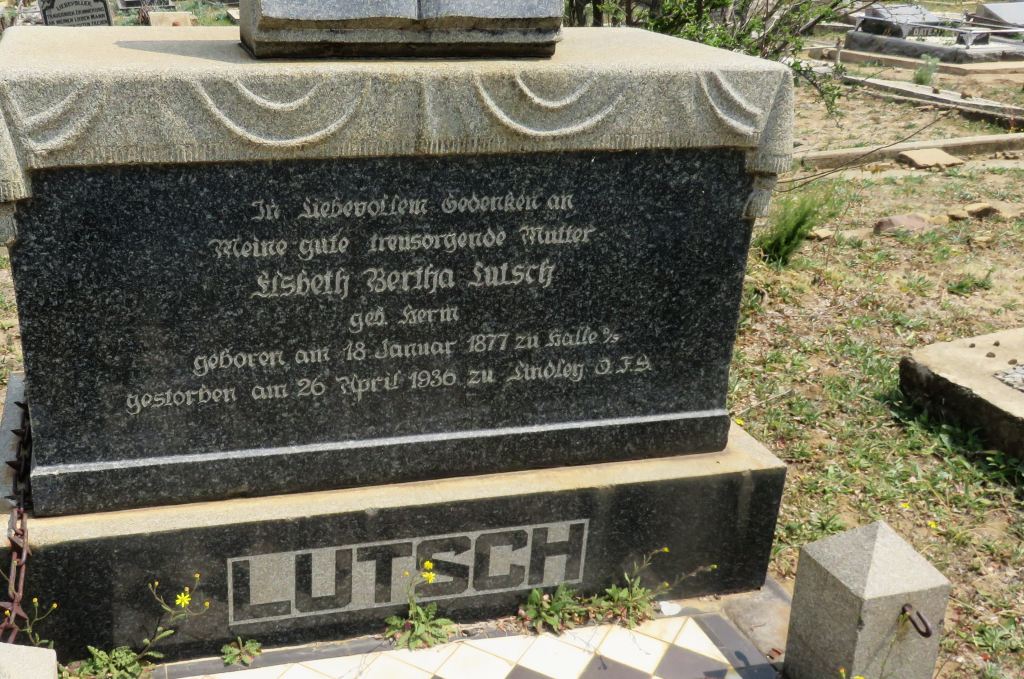 The med means that he studied medicine and was thus a medical doctor. What actually attracted me to this grave is the fact that his wife, Elisabeth Bertha Lutsch, was born in Halle a/s, that stands for Halle an der Saale and is 30km from my hometown in Germany, thus the instant connection.
The med means that he studied medicine and was thus a medical doctor. What actually attracted me to this grave is the fact that his wife, Elisabeth Bertha Lutsch, was born in Halle a/s, that stands for Halle an der Saale and is 30km from my hometown in Germany, thus the instant connection.
His grave stone reads: In liebevoller trauernder Erinnerung an meinen lieben Mann und meinen guten, treuen Vater, den praktischen Arzt Dr med. Walter Julius Friedrich Lutsch, geb. zu Doelitz in Pommern, 6 September 1862, gest. zu Lindley O.F.S. 3 Mai 1929. I don't need to translate, the facts are clear and the first sentence would give me some problems anyway translating it into elegant English. He came from Doelitz which is now in Poland.
I was told in town that he became known in South Africa as a person that proposed a general speed limit on all roads of 30, I presume that was 30 miles per hour, or 50 km per hours. That was in order to reduce the accident rate on the nations roads.
The Mill

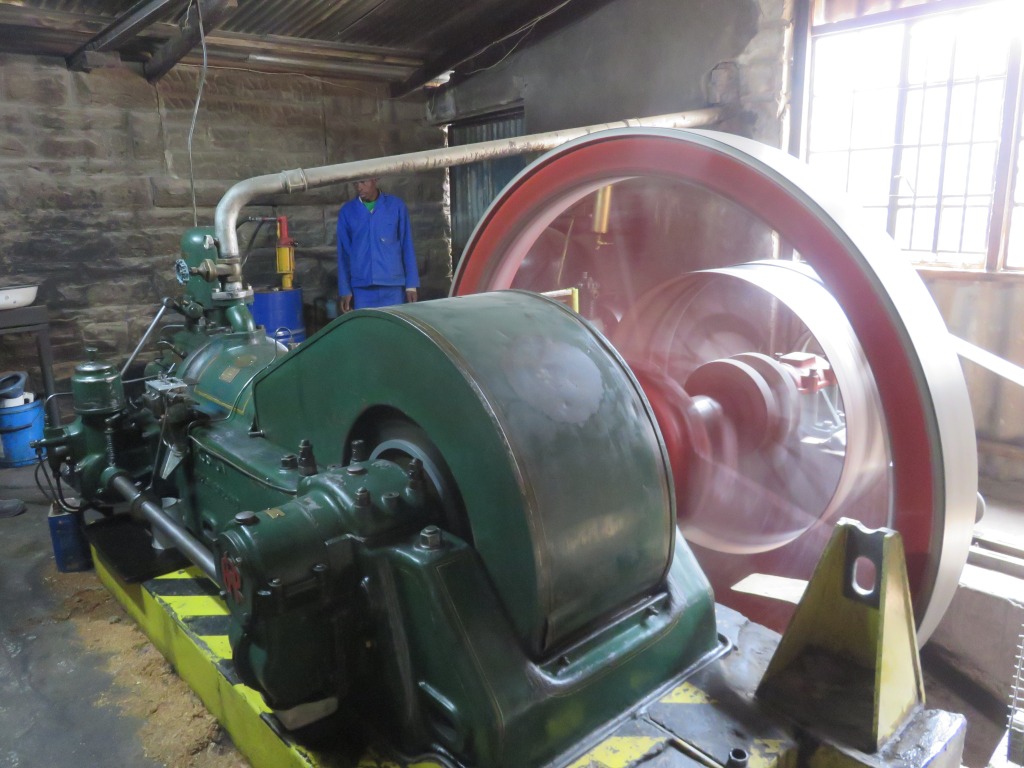 When Hekie van Rensburg bought the mill in the 1950th there was not much, he installed most of the machinery, which included the diesel engine as a primary power source. This is a Ruston & Hornsby Ltd, size 9X Class HR, manufactured in Lincoln England. It generates 65 horse power (40 kW) and runs at 250 rpm. A beautiful machine, it was an experience to see it started and running, see the video.
When Hekie van Rensburg bought the mill in the 1950th there was not much, he installed most of the machinery, which included the diesel engine as a primary power source. This is a Ruston & Hornsby Ltd, size 9X Class HR, manufactured in Lincoln England. It generates 65 horse power (40 kW) and runs at 250 rpm. A beautiful machine, it was an experience to see it started and running, see the video.
 The mill produces a variety of products, from crushed maize for fowl feed to sifted maize meal to make pap. The real claim to fame for the mill was that it supplied the mieliemeel (maize meal) to make the Pro-Nutro breakfast cereal. It was initially developed at the Lindley dairy in 1959. It is not a well established brand with a variety of flavours.
The mill produces a variety of products, from crushed maize for fowl feed to sifted maize meal to make pap. The real claim to fame for the mill was that it supplied the mieliemeel (maize meal) to make the Pro-Nutro breakfast cereal. It was initially developed at the Lindley dairy in 1959. It is not a well established brand with a variety of flavours.
Mr.van Rensburg is still running the mill, now aged 85 (Sept 2018), he has no plan of stopping. In his own words he will carry on as long as he is still fit and able. This is the way to see you through old age, that is my opinion.
The Museum
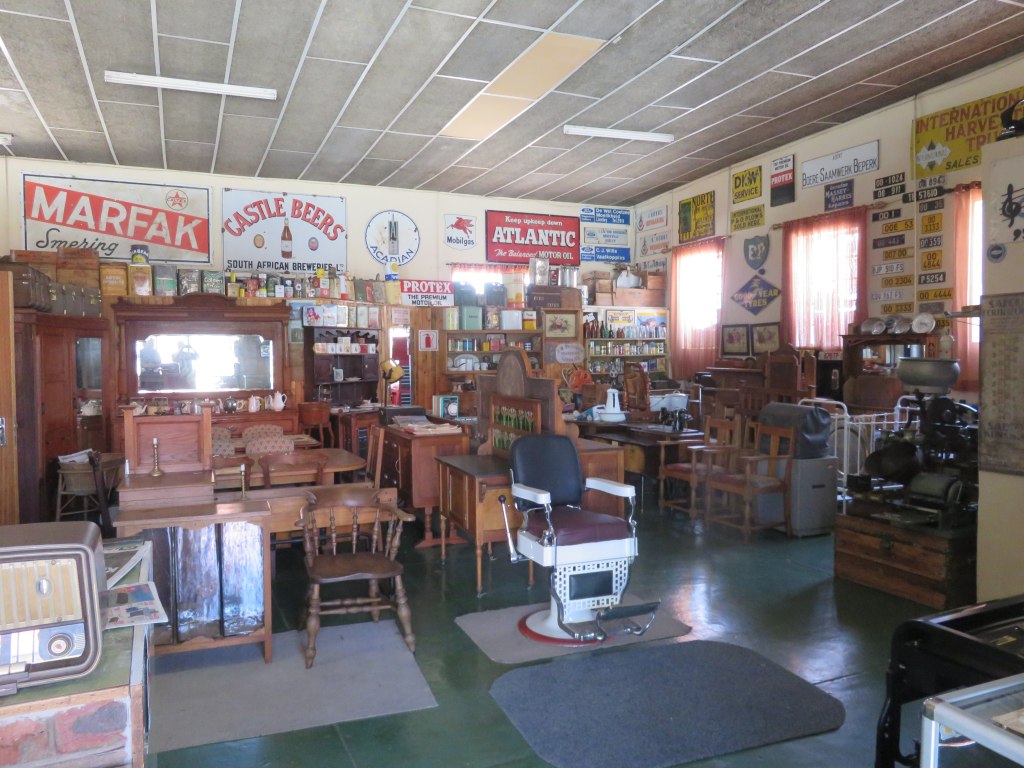 On the corner of Foutein- and Brand Street is a museum owned by Paul Fourie. It contains old furniture, utensils, books, pictures, cars and car related items. The cars are all Fords, vintage around 1960, all still roadworthy with up to date license. This used to be the Ford dealer in town. Pictures in general are all related to Lindley of the past.
On the corner of Foutein- and Brand Street is a museum owned by Paul Fourie. It contains old furniture, utensils, books, pictures, cars and car related items. The cars are all Fords, vintage around 1960, all still roadworthy with up to date license. This used to be the Ford dealer in town. Pictures in general are all related to Lindley of the past.
the swimming pool
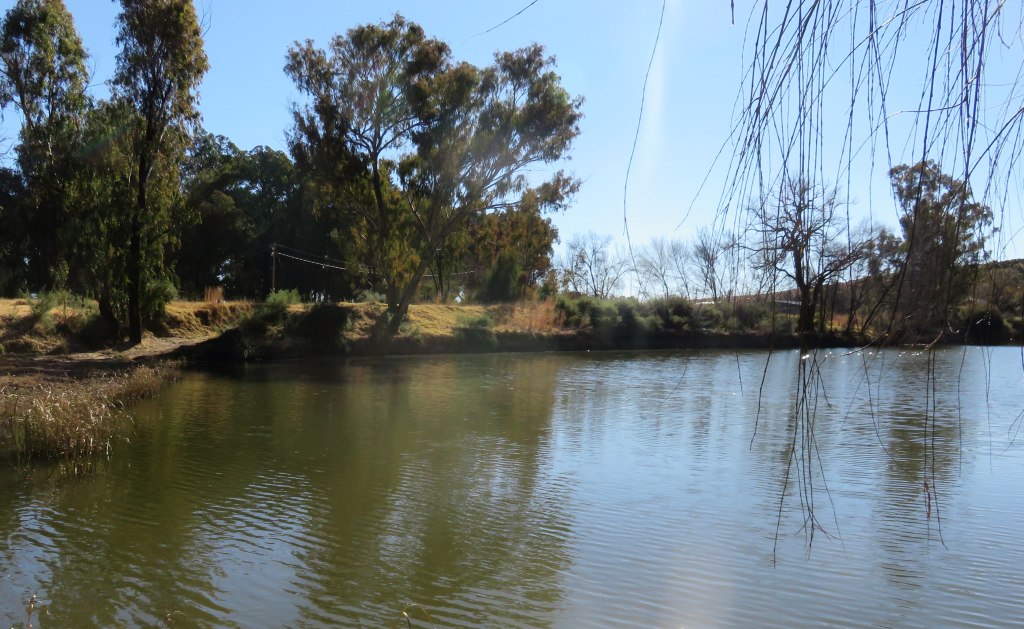
 The municipal pool is not in use. It became a victim of the change of government in 1994, when the still white town council decided to rather close it down than it being invaded by the other people. But strange the new town council has not seen fit to re-open it again. I have no information of when it was built, it got it's name, Joel Herholdt, because he was the donor that financed the construction at the time.
The municipal pool is not in use. It became a victim of the change of government in 1994, when the still white town council decided to rather close it down than it being invaded by the other people. But strange the new town council has not seen fit to re-open it again. I have no information of when it was built, it got it's name, Joel Herholdt, because he was the donor that financed the construction at the time.
Ref 8 gives an account of the bathing situation in earlier days. To secure the water supply for the town a weir had been constructed in the Vals river, I am not sure when. This weir damed up the water and formed a lake of 3 miles long, providing a nice lake for water sport. The article talks about the municipality putting up bathing huts at a place not far from the weir. The article also describes that there was strict gender separation, one day was for the boys and the next for girls, no mixed bathing was allowed.
This sort of conservatism carried on in the Free State for many years. I remember reading a report in the late 60th (last century) about bathing regulations which specified a minimum distance between male and female when sun bathing.
The weir was later replaced with a dam wall, raising the level a few meters. The picture shows the lake as it is now and the swimming area would be in this vicinity but under water.
The battle of Bakenkop
 C.de Wet in his book, Ref 4, describes this as the action at Elandsfontein.
C.de Wet in his book, Ref 4, describes this as the action at Elandsfontein.
The background to it is that the British forces were moving toward Bethlehem. At Bakenkop they met resistance from the Boers.
Quoting directly from the book:
The English were unopposed until they reached Elandsfontein, but there a battle took place in which big guns played the main role, although there was also some heavy fighting with small arms.
In this engagement Commandant Michal Prinsloo did a brave deed. I arrived at his position just after the burghers had succeeded in shooting down the men who served three of the enemy's guns. With a hundred men he now stormed the guns, hoping to be able to bring them back with him to our lines. Whilst he charged, I cannonaded the enemy, with a Krupp and fifteen pound Armstrong, to such good effect that they were forced to retreat behind a ridge. In this way Commandant Prinsloo reached the guns safely, but he had no horses with him to drag them back to us. He could do nothing but make the attempt to get them away by the help of his burghers, and this he tried to accomplish under a fierce fire from the English. But he would still have succeeded in the endeavor, had not unfortunately a large force of the enemy appeared on the scene, and attacked him and his hundred burghers. I was unable to keep the English back, for both my guns had been disabled. The nipple of the Armstrong had been blown away, and, for the first time, the lock of the Krupp had become jammed. Had it not been for this mishap, Commandant Prinsloo would certainly have been able to remove the guns to the other side of a ridge, whither teams of our horses were already approaching. But, as it was, he had to hurry away as fast as possible, and leave the guns behind.
When the enemy arrived they had outflanked us so far to the north, that we had nothing open to us but again to abandon our positions. We therefore retired to Blauwkop, and on the following day to Bethlehem.
According to the description on the monument, the Boers were firing their guns from Bakenkop and the British from Leeukop. The monument was erected just between the two koppies. For more information the inscription on the monument:
LEEUKOP AND BAKENKOP; On 3 July 1900 Boer Artillery on Bakenkop and nearby kopjes engaged in a lengthy duel with a British battery on Leeukop. In mid afternoon about 100 burghers approached the British ridge unseen through a mealy patch and dead ground. In heavy rain they stormed the ridge, capturing three guns briefly before being driven off by Australian troops. To the memory of the men of all nations who fought here including:
Major H.E.Oldfield, Captain C.E.D.Budworth and the gunners of the 38th field battery RFA and a section of the HAC.
Commandant Michael Prinsloo's storm party and the gunners of the Het Artillerie Corps, OFS.
Captain A.E.M.Norton D.S.O. and the 4th South Australian Imperial Bushmen who retook the ridge.
Leghoya ruins at Leeukop
 On top of Leeukop are some ruins of beehive stone huts and other structures. It is a fairly substancial area, best observed from above. The Google Earth picture shows the extend. And this is not the only place where one can find these ruins, moving around with GE they are also on Bakenkop and on other hills.
On top of Leeukop are some ruins of beehive stone huts and other structures. It is a fairly substancial area, best observed from above. The Google Earth picture shows the extend. And this is not the only place where one can find these ruins, moving around with GE they are also on Bakenkop and on other hills.
I was told that tests done on some of the implements found there, showed that the ruins were 'active' at around the 14th century. I picked up a piece of pottery, of about 2cm thickness and from the curvature I calculated the pot to be about one meter in diameter.
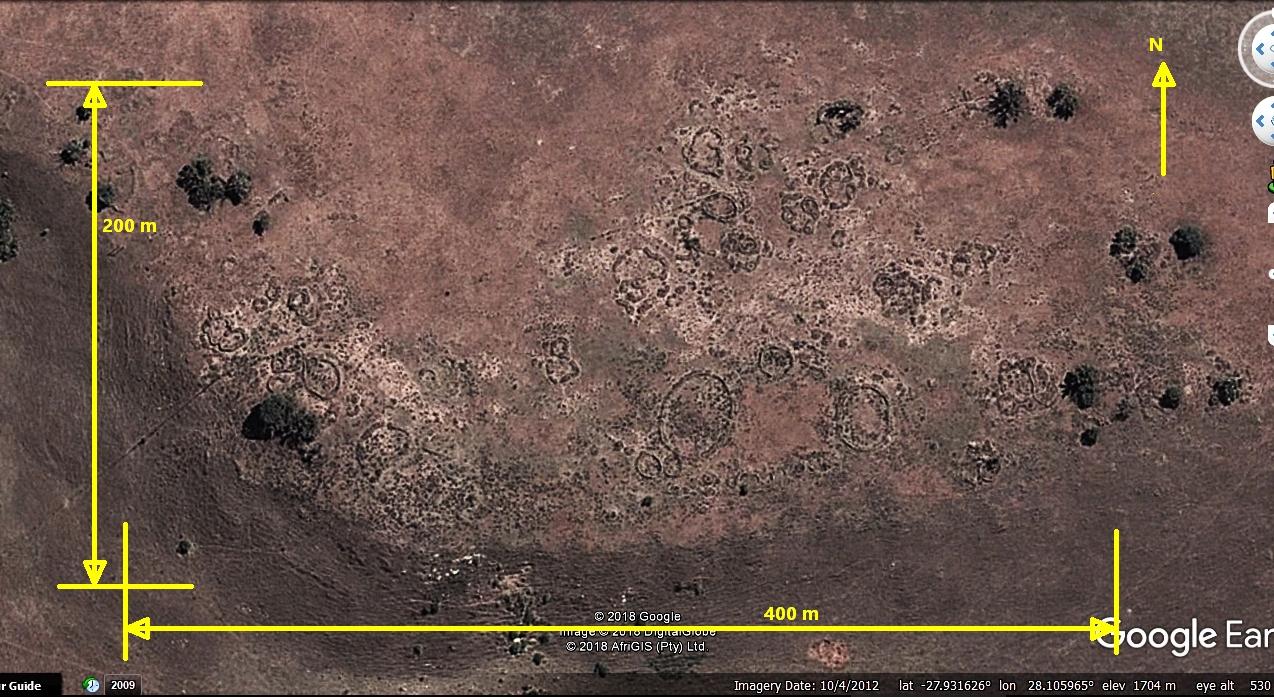 And something else that struck me about the place is the big oval near the center of the picture, its almost perfect. The two diameters are 38m and 29m. To me this is very interesting, what could have been the purpose of such an accurate layout? And what methods did they use?
And something else that struck me about the place is the big oval near the center of the picture, its almost perfect. The two diameters are 38m and 29m. To me this is very interesting, what could have been the purpose of such an accurate layout? And what methods did they use?
Doornkloof
Doornkloof is a historical farm that used to belong to the Voortrekker leader Sarel Cillier. There is a lot to be written about Doornkloof, thus I have given it its own page, try Doornkloof.
Groenvlei Voortrekker cemetery
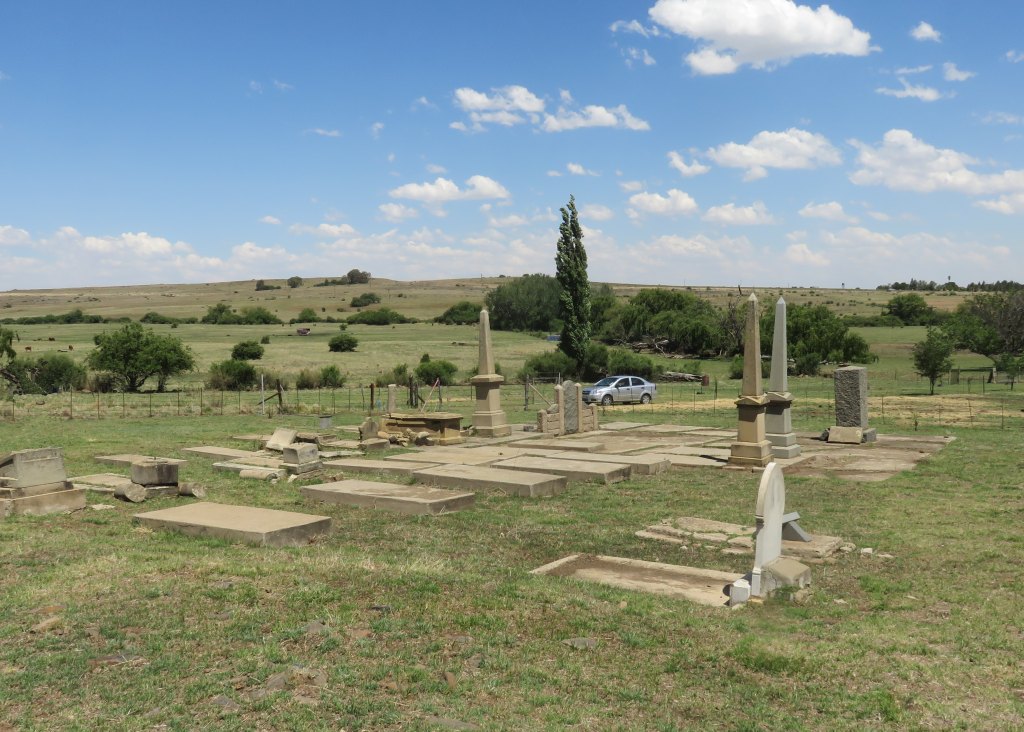
 At Groenvlei, about 10km out of town on the road to Petrus Steyn, is a Voortrekker grave yard. I provide some details of some of the names found there.
At Groenvlei, about 10km out of town on the road to Petrus Steyn, is a Voortrekker grave yard. I provide some details of some of the names found there.
Anna and Thomas Steenkamp
The most notable graves are those of Mr.and Mrs.Steenkamp. The inscriptions read: Anna; Elizabeth; Steenkamp; (geb Retief); 1797-1891; Opgerig; deur haar afstammelinge; 16-Dec-1924; Bruwer' Bodenstein; Davel, Hattingh, Heydenreich; Malan, van der Merwe; (the semicolon marks the end of a line). The other stone reads: Hier Rus; Thomas Ign Jac; Steenkamp; geb. 29 Mai 1791; vermoor deur; basoetoes; 22 Julie 1865; te Groenvlei;. Translation: Anna Elizabeth Steenkamp (born Retief) 1797-1891, erected by her descedants 16-Dec-1924 and list of names. Note she made it to 94 years, an unusual old age for those days when life expectancy was somewhere in the 60th. And the other stone: here rests Thomas Ign Jac Steenkamp born 29 May 1791, murdered by the Basutus 22 July 1865 at Groenvlei. The Ign stands for Ignatious. That was at the beginning of the 2nd Basuthu war, president Brand called out the commandoes on 9 June 1865 to ride against king Moshesh. I presume Thomas stayed on the farm, not being liable for call-up due to age.
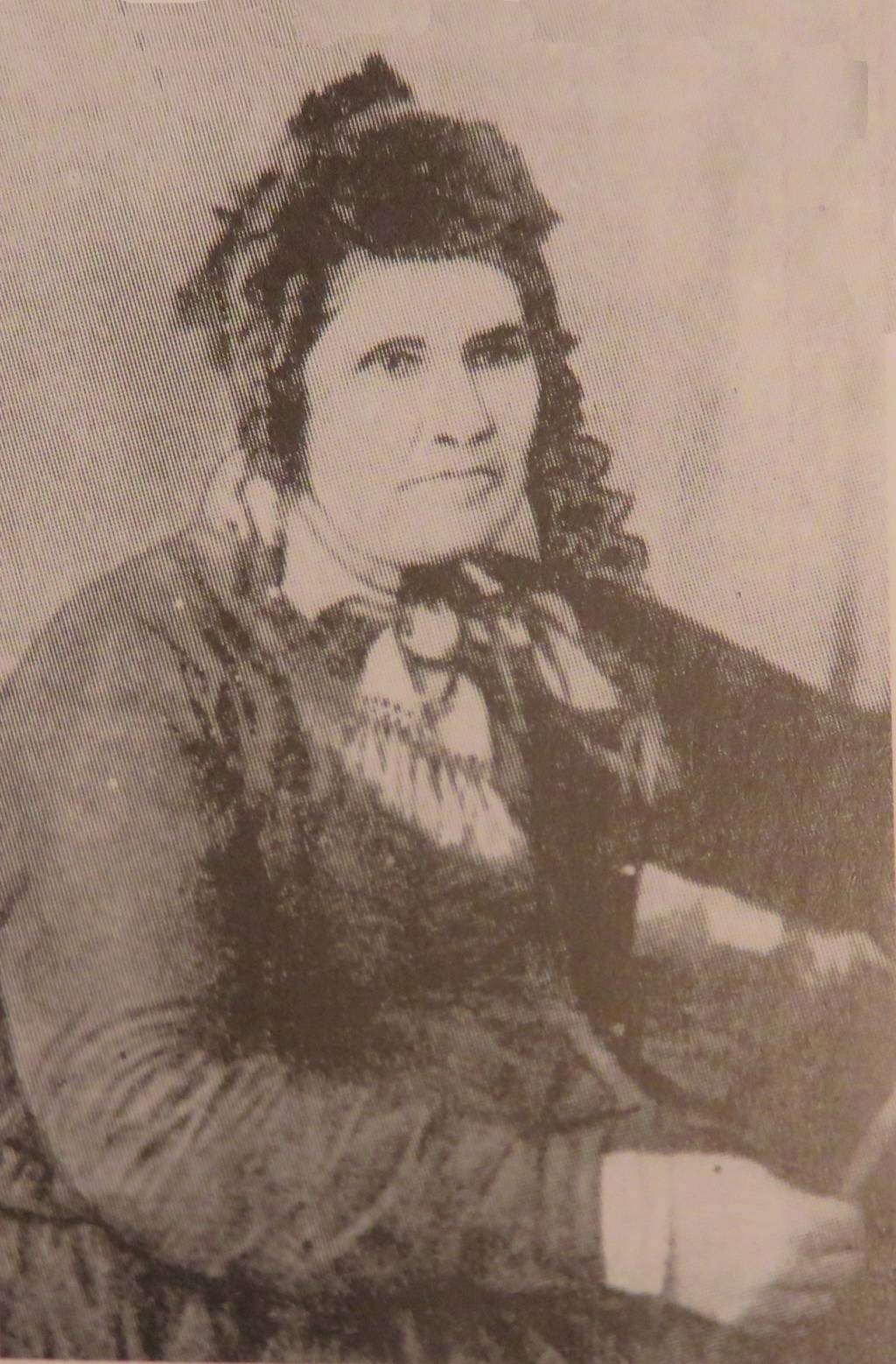 We do know a bit about Anna and her family because she kept a journal and has written down her memories, as she puts it, for her children and grand children. She certainly had a hard life, being on the trek into Natal, being in the area when Piet Retief and his men were murdered and when all the murders at Bloukranz happened and in Pietermaritzburg when the British took over. Details can be found here.
We do know a bit about Anna and her family because she kept a journal and has written down her memories, as she puts it, for her children and grand children. She certainly had a hard life, being on the trek into Natal, being in the area when Piet Retief and his men were murdered and when all the murders at Bloukranz happened and in Pietermaritzburg when the British took over. Details can be found here.
Anna Retief was born in 1797, christened on the 5 Feb 1797, her father was Francois Retief, the older brother of Piet Retief. 1812 she married Johannes Dewald Hattingh at Graaff-Reinet. He is described as a sickly man, who's sickness caused the family to delay joining the trek at the beginning. They followed 7 month later and caught up with the Retief party on the way to Natal.
They were caught up in the horrific events at Bloukranz. From the information available I cannot determine where she and her family were exactly, they did escape unhurt. And they survived further trouble by moving to the fortified camp of Gerhard Maritz.
In August 1838 her husband died of blackwater fever, a complication of malaria. She soon married again, as she puts it in her memories:"Ik ben ook weer hertrouwd met 'n onbekende man, 'n weduwnaar, genaamd Thomas Eugenaar Steenecamp", translated: I got married again with an unknown man, a widower, named Thomas Eugenaar Steenecamp. He, Thomas, and his first wife, Clara Isabella born Potgieter, had been in the trek north with Potgieter. She was a sister of the Voortrekker leader Andries Hendrik Potgieter. He must have come to the area to help with the fight against Dingaan. His name is mentioned in the list of fighters having taken part in the battle of blood river.
The family moved down to Maritzburg and when the British took over they moved back inland to live with her son, Christiaan Hattingh, on the farm Groenvlei near Lindley. Thomas was murdered in the 2nd Basuto war, 1865, at the age of 71. His death is mentioned in Ref 7. He was with his sheep when the Basutos attacked, he received 7 stab wounds and died the same evening. The date of his death is actually wrong on the gravestone, there it is given as 22 July, but in actual fact it was the 22 June. Anna lived on to a good age of 94.
Christiaan Hattingh
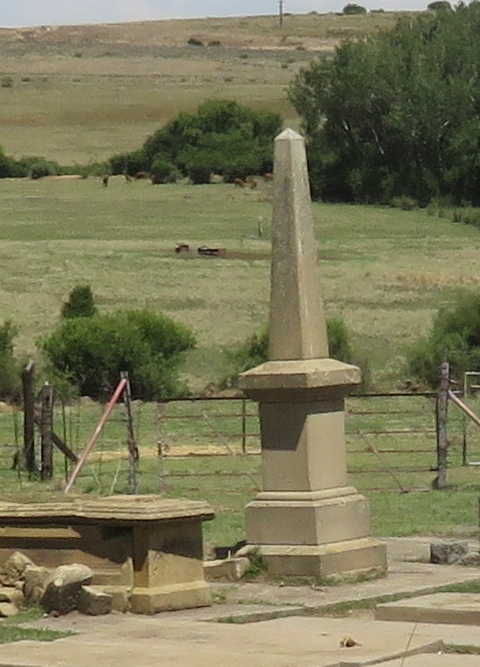 Also a Bloukranz survivor, with his mother Anna Steenkamp. The grave stone of Christiaan Hattingh, it reads, translated: In memory to our; father and grandfather; Christiaan Johannes; Hattingh; born 9 Nov 1830; died 25 March 1919. It shows he was 8 when he was at Bloukranz. And he lived to the old age of 89, similar age as his mother.
Also a Bloukranz survivor, with his mother Anna Steenkamp. The grave stone of Christiaan Hattingh, it reads, translated: In memory to our; father and grandfather; Christiaan Johannes; Hattingh; born 9 Nov 1830; died 25 March 1919. It shows he was 8 when he was at Bloukranz. And he lived to the old age of 89, similar age as his mother.
Boer War
 Also on the graveyard is a collective grave of burghers who died during the Anglo Boer war in the area. The head stone reads, translated: to the memory of fallen burghers who offered their life for folk and country in the second war for freedom; 1899-1902; re-interned on the 10 October 1958; (1) S.S.Strydom (Veldkornet); (2) N.Beukes; (3) ?? Terblanche; (4) M.J.Smalberger; (5)D.R. de Wet; (6) W.N.Pieters; (7) M.J.Pieters; (8) J.Pieters; (9) C.J.Nagel (Veldkornet) (10) J.J.du Plessis; (11) G.Mienie.
Also on the graveyard is a collective grave of burghers who died during the Anglo Boer war in the area. The head stone reads, translated: to the memory of fallen burghers who offered their life for folk and country in the second war for freedom; 1899-1902; re-interned on the 10 October 1958; (1) S.S.Strydom (Veldkornet); (2) N.Beukes; (3) ?? Terblanche; (4) M.J.Smalberger; (5)D.R. de Wet; (6) W.N.Pieters; (7) M.J.Pieters; (8) J.Pieters; (9) C.J.Nagel (Veldkornet) (10) J.J.du Plessis; (11) G.Mienie.
Seperate stones have been put up for S.J.Strydom (I presume it is the same as S.S. above) and M.J.Pieters.
References:
Ref 1: Standard Encyclopedia of Southern Africa
Ref 2: "Ons Kerk Album van Hollandsche Kerken en Leeraren", publisher: unknown, printed in the 1920's
Ref 3: Military History Journal, Vol 11 No 6 - December 2000, "THE OTHER DE WET Piet de Wet and the Boer 'Hendsoppers'
in the Anglo-Boer War".
Ref 4: Christiaan Rudolf de Wet,'Three Years' War', CHARLES SCRIBNER'S SONS, 1902
Ref 5: Military History Journal, Vol 15 No 3, Steve Watt, The Lindley Affair
Ref 6: NG Kerk Lindley 1876-1951, published by NG Sendingpers
Ref 7: G.B.A.Gerdener, 'Sarel Cilliers - Die Vader van Dingaansdag', 1919
Ref 8: a feature article in 'The Star' newspaper, 'Lindley on the Valsch river', date unknown, about 1927, the article is on display in the Lindley library.